9 Best Shoulder Stretches That Every Athlete Needs to Know (and Practice)
This article originally appeared on Yoga Journal
If you engage in any sort of athletic endeavor, you know that any stretching you do tends to emphasize the lower body, if you even stretch at all. It makes sense: Your hamstrings, quads, and calves tend to handle much of the strain. However, chest and shoulder stretches are equally essential--especially if you're a weight lifter, swimmer, climber, triathlete, or cyclist. When you don’t stretch, the tension and tightness build and eventually the resulting lack of mobility will impair your ability to do what you love.
You may not have any chest and shoulder stretches in your repertoire. Some of the stretches in the following routine may seem simple, yet they underscore the fact that you don't need to complicate things to experience surprising results.
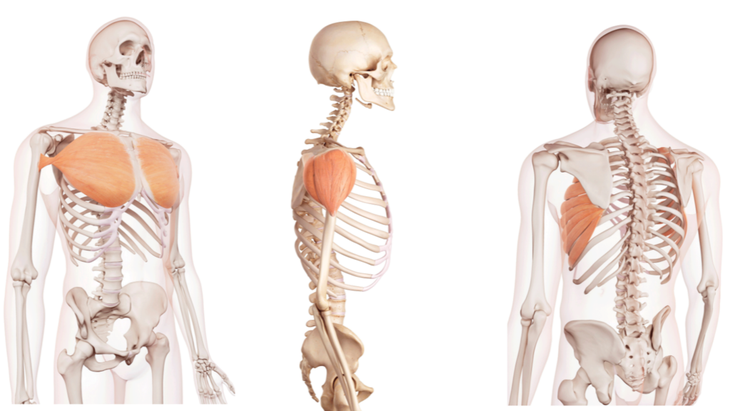
The Anatomy of Chest and Shoulder Stretches for Athletes
If you want to ensure you have a well-balanced recovery routine, you need to target the following muscle groups: the pectoral muscles of your chest, the deltoid and rotator cuff muscles in your shoulders, the triceps and biceps in your upper arms, and the rhomboids, traps, lats, and serratus anterior muscles in your upper back.
Some of these dynamic stretches work well as a warm-up while others are strong recovery options. By integrating these stretches into your routine, you'll experience more mobility and flexibility throughout your upper body, not only when you’re working out but in your everyday life.
Keep in mind, it’s not how the stretch looks, it’s how it feels. Don’t force yourself into a more intense version; that will only cause your body to tighten in response. Keep things at a comfortable discomfort at most.
The 9 Best Shoulder Stretches for Athletes
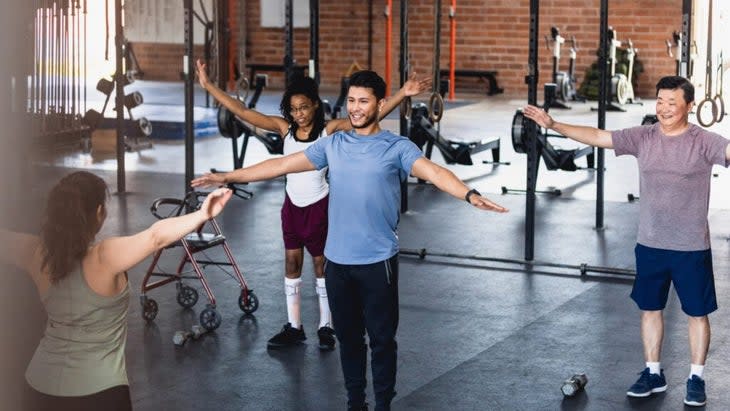
1. Arm Circles
Benefit: Practice this dynamic stretch before any workout to start to invigorate and release your deltoids, triceps, and biceps.
How to: Stand with your feet hip-distance apart and bring your arms straight out to the sides in a T-shape. Slowly rotate both arms forward, tracing small invisible circles with your fingers. Keep your elbows straight. Gradually increase the size of the circles with each circle. Complete 15 arm circles. Reverse the direction of your circles and repeat.
Add to your yoga practice: Practice this in Mountain Pose (Tadasana). You could also incorporate it into a High Lunge.
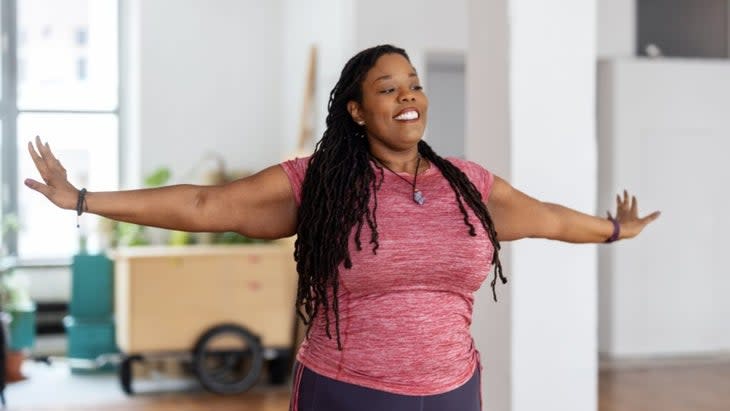
2. Trunk Twists
Benefit: This stretch works well as a warm-up to open up your obliques, upper back, and chest.
How to: Stand with your feet hip-distance apart. Bring your arms straight out to the sides in a T-shape. Keep your hips square. Rotate and twist your torso from right to left and back again. Gradually increase the speed and range of motion. Twist for 30 seconds.
Add to your yoga practice: Add it in Tadasana (Mountain Pose). You could also include it to Chair Pose (Utkatasana) or Seated Easy Pose (Sukhasana).
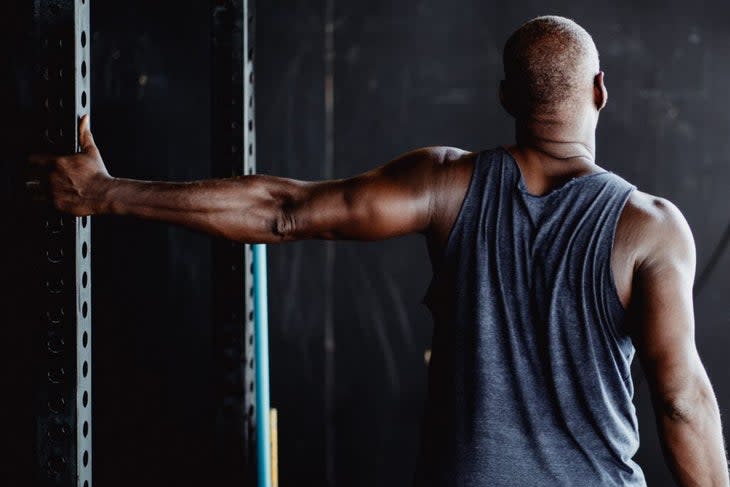
3. Chest Stretch
Benefit: If you're looking for a post-workout upper body and shoulder stretch, this is it. Focusing on the pectoral muscles in your chest and the fronts of your shoulders, this exercise is particularly helpful for cyclists who spend hour after hour hunched forward.
How to: Face a doorway with your arms straight out to the sides in a T-shape or stand alongside an upright bar at the gym and stretch one side at a time. Step your right foot far enough forward through the doorway so that your arms rest against the doorframe. You can control the intensity. You want to feel a stretch across your chest and the fronts of your shoulders. Keep your spine neutral, gaze straight ahead, and core engaged. Stay here for 30 seconds. Repeat on the other side.
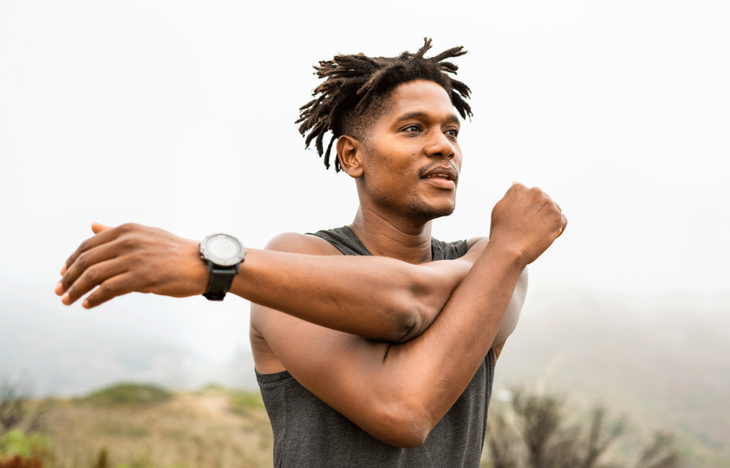
4. Shoulder Stretch
Benefit: As the most mobile joint in your body, your shoulders handle a lot of intensity. This post-workout stretch brings some much needed relief from tension to your deltoids.
How to: Bring your right arm in front of your body parallel to the floor. Keep your elbow straight. Hook your left forearm under your right and use it to pull your right arm across your body, toward your left shoulder. With your left hand or forearm, gently press behind your right elbow or the back of your upper right arm. Try to keep your straight arm in line with your shoulder rather than lifting it in line with your chin to isolate the intended muscles. Breathe here for 20 to 30 seconds. Switch sides and repeat.
Add to your yoga practice: Include this stretch in a cross-legged sitting position or in Mountain Pose. You can even do it reclining before you settle into Savasana.
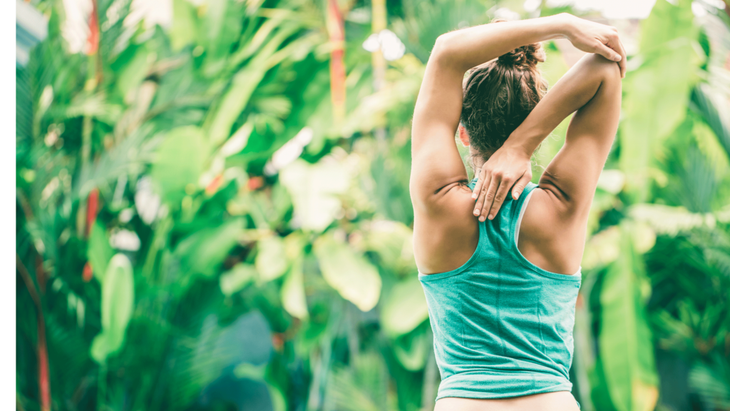
5. Overhead Triceps Stretch
Benefit: This stretch lengthens the namesake triceps, of course, as well as your deltoids and tricky-to-target latissimus dorsi. You can
How to: Straighten your right arm overhead. Bend your right elbow so it points toward the ceiling and reach your fingertips toward your spine. Take your left hand to your right elbow and exert just enough pressure to pull the elbow slightly toward your midline, deepening the stretch and bringing your right fingertips a little further down your back. Breathe here stretch for 20 to 30 seconds. Switch sides and repeat.
Add to your yoga practice: This can be done before class while you’re sitting on your mat.
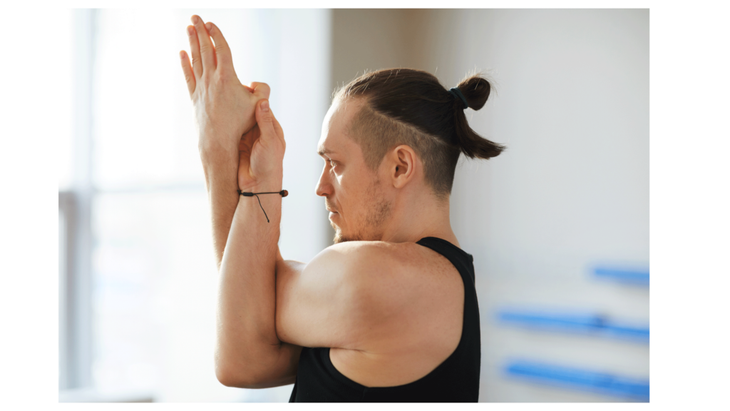
6. Eagle Arms
Benefit: If you practice yoga, you may already be familiar with this stretch as it’s difficult to forget (and easy to avoid). But it’s a great go-to move beyond your asana sessions for releasing the muscles in your upper back and shoulders, including the lats, rhomboids, traps, rotator cuffs, and deltoids.
How to: Sit on the floor with your legs crossed in a comfortable position. Bring your arms straight out from your shoulders and then bring them toward each other in front of your chest, crossing your right arm underneath your left. Bend your elbows and reach your fingers toward the ceiling. Try to press your palms or the backs of your hands together. Lift your elbows to shoulder height. Notice if you’re holding your breath and let out an exhalation. If your shoulder blades are crowding your ears or if your ribs are jutting forward, bring yourself back to a more neutral position by drawing your shoulder blades down and engaging your core ever so slightly. Breathe here for 20 to 30 seconds. Switch sides and repeat.
Add to your yoga practice: In yoga, Eagle Pose includes crossing one leg over the other and balance while also taking this shape with your arms. You can practice just the arms portion in many different poses, including Warrior 1, Humble Warrior, Warrior 3, and Chair Pose.
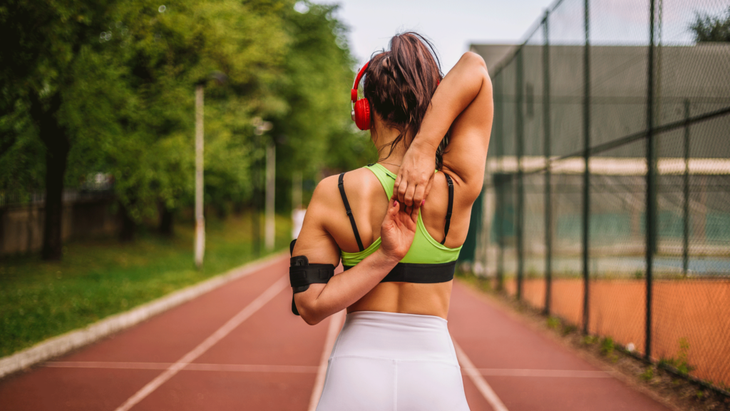
7. Cow Face Arms
Benefit: Another yoga-inspired shoulder stretch, Cow Face arms is an intense stretch your chest and shoulders. It builds on Overhead Triceps Stretch to include the other arm. If your fingers don’t touch, permission granted to grab your shirt or reach for a towel or strap.
How to: Stand or sit in a comfortable position. Lift your right arm alongside your ear, bend at your elbow, and reach your right fingertips toward your spine. Bend your left elbow, bring it near your left hip, and reach your left fingertips toward your right arm with your left palm facing away from you. Unless you are pretty flexible, your hands likely won't touch. You can grab your shirt or use a towel or strap to help bridge the gap. Breathe here for 20 to 30 seconds. Switch sides and repeat.
Add it to your yoga practice: This arm stretch is typically practiced seated in Cow Face Pose, with or without the traditional (and intense) crossing of the legs. Try incorporating it into High Lunge or Chair Pose and keeping your arms in place as you shift forward into Warrior 3 (Virabhadrasana 3).
8. Neck Stretch
Benefit: This gentle stretch can help loosen your upper traps and sternocleidomastoid muscle to relieve persistent neck tension upon getting out of bed or sitting at a computer.
How to: Tilt your head toward your right shoulder. Stay here or place your right palm slightly above your left ear but do not rest the weight of your hand on your head. Instead, press your head into your hand. You should feel a stretch along the left side of your neck. Breathe here for 15 to 20 seconds. Switch sides and repeat.
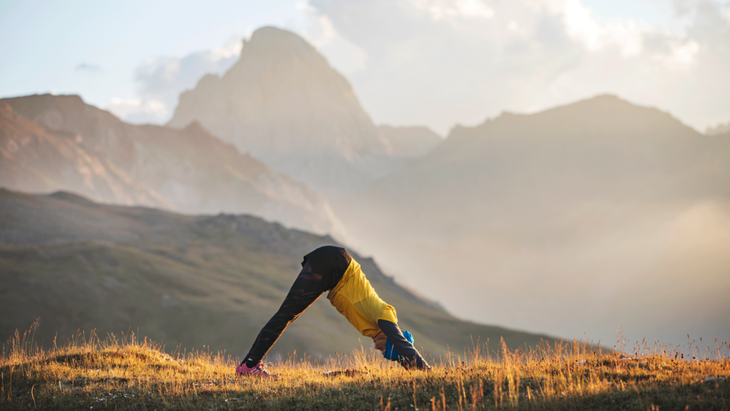
9. Downward Dog
Benefits: You may think of Downward Dog (if you think of it at all) as a lower-body stretch for your back, glutes, hamstrings, and calves. And you’re not wrong. But it also targets your entire posterior chain, including your upper back and shoulders as well as your triceps and even your forearms.
How to: Come onto hands and knees with your hands slightly in front of your shoulders and your knees underneath your hips. Spread your fingers apart and press your palms into the floor. Tuck your toes and lift your knees off the mat as you reach your hips toward the wall behind you. Your body should be folded at the hips in an inverted "V" shape. Reach your heels toward the mat but it’s okay if they don’t touch. Keep a bend in your knees if you need. Gaze at your navel or your thighs and keep your back straight and your neck relaxed. Breathe here for 30 seconds.
For exclusive access to all of our fitness, gear, adventure, and travel stories, plus discounts on trips, events, and gear, sign up for Outside+ today.

